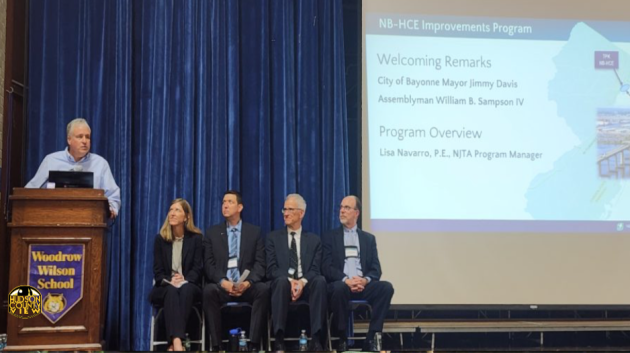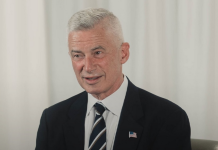The New Jersey Turnpike Authority (NJTA) held an open house at the Woodrow Wilson School in Bayonne yesterday on the on their Newark Bay-Hudson County extension proposal, which had protesters before the event even began.
By Daniel Ulloa/Hudson County View
This phase of the project is expected to cost $6.2 billion, with the turnpike widening valued at about $10.7 billion overall.
Protesters were especially unhappy about the section of the project of I-78 entering the Holland Tunnel.
At the protest prior to the open house, Hoboken Mayor and 8th District congressional candidate Ravi Bhalla argued the project would add more congestion and pollution.
“This is a travesty of justice that must be stopped now! They’re going to literally displace households! What you will see inside will be a PR stunt! We can invest this money in NJ Transit and lower fare hikes. It’s ridiculous. We’re raising fares on working families,” he exclaimed.
He also said that he’s not against repairing bridges and roads, but noted the cost has nearly tripled in the past year. The NJTA has previously attributed to the original $4 billion figure to using outdated information.
Jersey City Infrastructure Director Barkha Patel said she was there on behalf of Mayor Steven Fulop. She noted she previously spoke at a protest against the proposed widening of I-78 to the Holland Tunnel.
“This project is on the wrong side of history,” she declared.
“We’re calling on the Turnpike Authority … to conduct a full environmental impact statement for the entire project. Wider ways will not solve our congestion problem. We’re going to see our air quality worsen,” she argued, later noting that 7,000 people have signed a petition opposing the project.
“The climate risk in our region is significant. The status quo is extremely dangerous. We’re calling on our state to do more.”
Hudson County Commissioner Bill O’Dea’s chief aide Cory Garriga explained that he’s against it as well, which O’Dea expanded on in a post on X today.
“It is going to disproportionately affect low-income communities and people of color the most! They’re slowly killing us, and they don’t care!” Weequahic Park Association Executive Director Wynnie-Fred Victor Hinds exclaimed.
She argued many people in Newark already suffer from illnesses due in part to poor air quality at least in part caused by cars.
Addtionally, Jersey City Ward F Councilman Frank “Educational” Gilmore urged Gov. Phil Murphy (D) to “completely dismantle and get rid of this project.
Jersey City Ward E Councilman James Solomon expressed that the project will only get more expensive as time goes on
“Why are we doing this? It serves the political interests of the few. We want good union jobs that come from building mass transit,” he asserted.
Solomon also said some of his district would suffer from eminent domain, where the government can take private property if it argues it serves the larger community.
After the protest, many entered the school auditorium for the open house. Inside, the NJTA displayed poster boards that described the project in detail, along with graphics. Officials around the room answered questions from the public.
“We know some of you have some concerns,” NJTA Outreach Specialist Desiree Gazzo said to kick off the program.
She noted construction wouldn’t begin until 2026, which would then be done in multiple stages.
“We will not be taking questions during the presentation,” Gazzo continued.
“Why don’t you answer questions publicly?” a man in the audience yelled.
“I fully support this project. This bridge needs to be replaced. It was built for the traffic of 1950. This is another phase of keeping this whole area … competitive with jobs … Let’s build it for the future,” Bayonne Mayor Jimmy Davis declared to applause.
Assemblyman Will Sampson (D-31) noted that International Longshoreman Association (ILA) Local 1588 President Virgil Maldonado was there in support of the project.
“I will always stand with the labor movement … I am a public servant and I will always listen to the concerns of my constituents: it’s not about me, it’s not about what my vision is, it’s about the vision of my constituents – how do we make this a better city? How do we make this a better district? How do we make this a better state?” he declared.
Along with the ILA, many members of union workers and carpenters unions were present as well.
NJTA Program Manager Lisa Navarro explained the initial plan for the Casciano Memorial Bridge was approved in 1952 and opened in 1956.
“The extension is at the end of its life,” she asserted, indicating environmental and safety concerns had to be addressed in short order.
She explained that the overall project has been broken down into four mini-projects or phases.
The first phase is building a new bridge next to the Casciano Memorial Bridge, knocking down the existing one in phase two, and building a third one to handle traffic in the other direction, ultimately.
The fourth and final phase of the project consists of building 28 mini-bridges on the way to the Holland Tunnel.
“I’m pushing our team to open it by 2031. In our world, two years for planning and five years for the final project is not a long time,” Navarro said of the first phase, noting that the entire project likely wouldn’t be done until 2040.
“There’s a lot misinformation surrounding the program. The existing bridges cannot be rehabilitated. We are dealing with significant structural and sub-structural challenges. There will be no residential displacement,” Navarro added.
Navarro said the NJTA has the billions it needs for the project and would not need additional taxpayer money from the city, county, state, or federal governments. She also indicated that the funds allocated to this project could not go towards rail improvements.
“The unused money cannot be used for NJ Transit. The NJTA has a covenant with its bondholders … These bridges cannot handle the current weight of trucks. There is constant maintenance and repair work being done,” Navarro noted, claiming the project would create 25,000 jobs..
Navarro also said that the project meets their priority of minimizing environmental impact.
“It requires very narrow work zones which comprises safety,” consulting engineer Dave Mykulak said about the repairs.
He argued something similar to the Baltimore bridge collapse needs to be avoided in Hudson County.
Senior Vice President of the consulting firm WSP Larry Pesesky said they have a draft environmental assessment ready that says they would not need to acquire any new land.
“The project will not have an adverse effect on the community’s quality of life,” he stated.
Consulting engineer Michael Morgan said they want to create four lanes on two bridges which should help with congestion. He argued a new bridge can accommodate the traffic and therefore actually have less delays.










